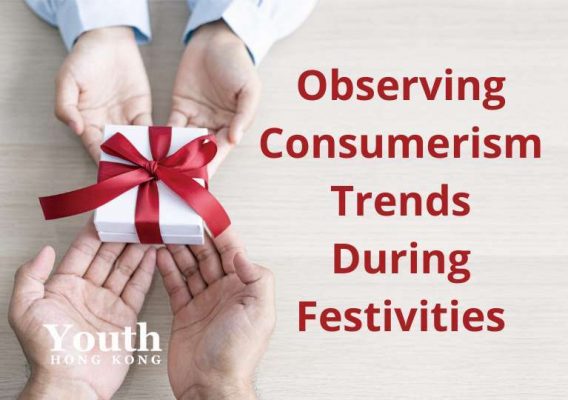//vol.14-4 Talking Point
Asian festivities often signify a time of celebration and sharing of merry moments over heightened consumerism during the year end. Be it Christmas, Chinese New Year or Easter, every festivity is celebrated with lots of love and passion through the spirit of gift-giving. YHK spoke to Dr. Tim Rosenkranz from the Chinese University of Hong Kong and Professor Christine Loh from the Hong Kong University of Science and Technology on such marketing tactics, also known as festive advertising.
- Heightened consumerism often result from a time of celebration especially during Asian festivities.
- From an anthropological perspective, it is about the shared understandings of what the items, gestures, or interactions are being conveyed. Indirectly, it thus becomes a subtle form of communication through giving and receiving through the gift.
- The COVID-19 global pandemic has resulted in major changes to advertising, marketing, promotional and media spends, forcing businesses and brands to re-evaluate their thinking about current and future advertising and marketing campaigns. While brands currently seek to strike the right tone during a global health emergency, the future portends market alteration, increased competition and a demand for creative and aggressive marketing practices.
- 一年一度的特別節慶,商家總會鋪天蓋地地宣傳。受消費主義影響下,有時候親友慶祝共度美好時光,也會造成不必要的浪費。
- 從人類學的角度來看,這是對於所傳遞的物品、態度或互動的共同理解。贈送禮物因而間接成為一種通過「付出和接受」而來的交流方式。
- 新冠疫情席捲全球,導致廣告、市場營銷、促銷和媒體支出產生重大變化,迫使企業和品牌重新評估他們對廣告和營銷活動的需要及前景。儘管各大品牌希望在全球衛生緊急危機下,找到適合自己的定位,但未來正預示會出現市場變化、加劇競爭以及對創造性銷售策略的需求。
Festive or occasion-based advertising has typically been of a tactical nature with brands focusing on discounts or freebies to trigger a purchase. It is only now that the brands have started crafting festive communication around insights relevant for the time or the season.1
To begin with, let us explore the origins of gift-giving. According to Dr. Rosenkranz, the exact century remains to be unknown till the current time. Gift-giving evolved rather naturally among humans, and only began to have more significance in the social relationships at different times and societies. Gift-giving creates and nurtures social bonds, and it is not just about the giver, but also about the receiver. A ring popping up during a proposal signifies a nuptial engagement. This further translates to lasting connections and mutual obligations, and which the receiver is expected to “give back” through the exchange of another ring to signify commitment.
Dr. Rosenkranz adds that because gifts are about meaningful, mutual relationships, it matters deeply what and how much the giver and receiver both give and get. From an anthropological perspective, it is about the shared understandings of what the items, gestures, or interactions are being conveyed. Indirectly, it thus becomes a subtle form of communication through the giving and receiving of gifts. How much or little that are given could sometimes be an one-time occurrence, but usually is embedded in ongoing and long-time circulations of giving and receiving with different people.
Prof. Loh gives a different perspective on consumerism, where consumers are basically users of certain products who buy them for their own consumption. In affluent Hong Kong, affordability is not an issue to most people, and consumerism is then extended to ‘needs’ becoming finite, while ‘wants’ can also turn infinite.
This is also where extended consumerism takes place, where people end up buying more than needed, such as clothes and food, through the habit of overpurchasing and end up not consuming, which leads to waste.
Consumerism Challenges the Gift-Giving Tradition
Dr. Rosenkranz adds, “Consumerism is often some sort of normative shorthand for excessive capitalism; the judgment that we buy and consume too much and too fast without getting lasting satisfaction. If you want to apply this to gift-giving, something seems to get lost on one hand. Why do we need to give more and more products to express and maintain our mutual relationships? Is that necessary? Does this not create frustrations and anxieties for those who cannot give more?
“But, on the other hand, does that mean that giving less is better? That really depends on the specific and different kinds of social relationships.”
Prof. Loh comments that the COVID-19 pandemic has also changed our regular activities almost overnight. Working from home became prevalent, and indirectly affected many people’s habits and buying behaviour worldwide. She says, “For example, adult consumers started to improve their workspaces and work equipment at home, and likewise for schoolchildren who have to have their lessons online through the use of smart gadgets and paid virtual connectivity subscription.
“People no longer needed to travel to their offices to work. The substitute for eating out was replaced with ordering online for deliveries and cooking at home. The pandemic experience showed how our activities affected what we consumed. Facemasks became a big business, and you can see many types and designs on the market. Wastefulness in food and packaging also became a major problem.”
Post-Pandemic Impact on Festive Gifting
The COVID-19 global pandemic also resulted in major changes to advertising, marketing, promotional and media spends, forcing businesses and brands to re-evaluate their thinking about current and future advertising and marketing campaigns. While brands currently seek to now strike the right tone, the future portends market alteration, increased competition and a demand for creative and aggressive marketing practices.2
Though the pandemic and ensuing lockdowns came as a sudden blow, many retailers are bouncing back to normalcy and the retail sales boom observed at the peak of the festive season is a testament to the improving consumer sentiment. It was reported by the South China Morning Post (SCMP) in January 2022 that thousands of Hong Kongers were reportedly flocking to the Mong Kok Kong flower market, to do their festive shopping ahead of Lunar New Year when the local health authorities decided to cancel traditional Lunar New Year fairs, disappointing shoppers and florists alike.3
Minimalism, on the contrary, is gaining traction among consumers in recent years. Movements like the Buy Nothing initiative and decluttering techniques by Marie Kondo are just some examples. Prof. Loh says, “Minimalism is a reaction to rampant consumerism. The message is ‘It is not cool to be wasteful’. You may remember it used to be popular to advertise Hong Kong as a place where you can ‘shop and eat till you drop’, This is now very uncool. Minimalism and decluttering are also seen as liberating, as having lots of “stuff” weighs people down – materialism is a burden. Having said that, consumerism remains a major problem in terms of how it negatively impacts the environment.”
Prof. Loh concludes that it is still possible to change consumers’ buying behaviour when consumers realize part of their actions can be harmful and excessive. “We can perhaps make it simple by focusing on (marketing) campaigns that resonate across society in general. Personally, I would choose to focus on campaigns to get people to reduce food waste.” ![]()
 Dr. Tim Rosenkranz is a Lecturer in the Department of Anthropology at The Chinese University of Hong Kong. His research explores the global commodification processes of national destination marketing that turn nations into tourist destinations.
Dr. Tim Rosenkranz is a Lecturer in the Department of Anthropology at The Chinese University of Hong Kong. His research explores the global commodification processes of national destination marketing that turn nations into tourist destinations.
 Professor Christine Loh, SBS, JP, OBE, Chevalier de l’Ordre National du Mérite, is Chief Development Strategist at The Hong Kong University of Science and Technology. She was Under Secretary for the Environment in the HKSAR Government (2012-17) and a Member of the Hong Kong Legislative Council (1992-97 and 1998-2000). She has taught a course for five years on non-market risks at the Anderson School of Management, University of California at Los Angeles. She is a published author of many academic and popular works. Prof. Loh is a lawyer by training, and a commodities trader by profession.
Professor Christine Loh, SBS, JP, OBE, Chevalier de l’Ordre National du Mérite, is Chief Development Strategist at The Hong Kong University of Science and Technology. She was Under Secretary for the Environment in the HKSAR Government (2012-17) and a Member of the Hong Kong Legislative Council (1992-97 and 1998-2000). She has taught a course for five years on non-market risks at the Anderson School of Management, University of California at Los Angeles. She is a published author of many academic and popular works. Prof. Loh is a lawyer by training, and a commodities trader by profession.
References:
1. https://www.socialsamosa.com/2019/09/festive-advertising-importance-of-seasonal-marketing-campaigns/
2. https://www.medianews4u.com/understanding-evolved-marketing-patterns-in-the-post-pandemic-festive-season/
3. https://www.scmp.com/news/hong-kong/hong-kong-economy/article/3163538/coronavirus-thousands-flock-popular-hong-kong


